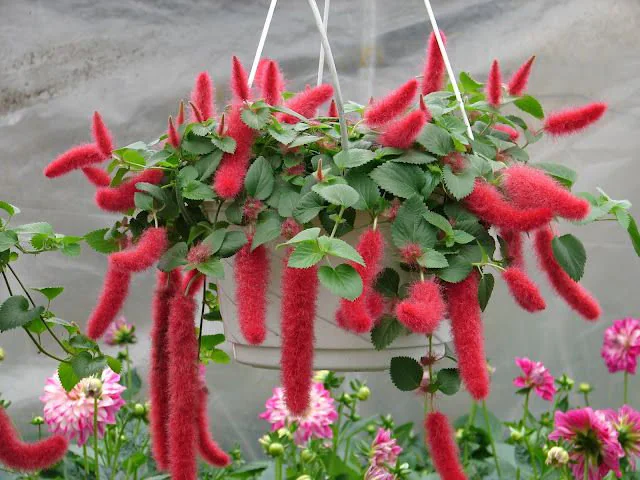Strawberry Firetail, also known as Chenille Plant Dwarf, is a low-growing tropical perennial prized for its vibrant red, fuzzy tail-like flowers and lush green foliage. Although not a true grass, its compact, spreading form and colorful plumes have earned it the nickname “Strawberry Firetail grass” among gardeners. It’s perfect for hanging baskets, borders, and ground cover in warm climates or as an annual in cooler zones. Let’s dive into how to care for this charming plant.
1. Overview and Appearance
Strawberry Firetail is a cultivar of Acalypha reptans, part of the Euphorbiaceae family. It grows up to 12 inches tall and spreads up to 24 inches wide, making it ideal for ground cover. Its most distinctive feature is its bright crimson, tail-like flowers that resemble miniature chenille pipe cleaners. These flowers bloom prolifically in warm months and can persist nearly year-round in tropical climates.
2. Light Requirements
Strawberry Firetail thrives in bright, indirect light. For best blooming, provide at least 4–6 hours of sun daily, preferably morning sun and afternoon shade in hot climates. In full sun, the foliage may scorch if not acclimated, while in too much shade, blooming will be sparse and the plant may become leggy.
- Outdoors: Partial sun to light shade.
- Indoors: Place near an east or west-facing window.
3. Soil Preferences
This plant enjoys well-draining, fertile soil with a slightly acidic to neutral pH (around 6.0–7.0). Amend garden beds with compost or organic matter to improve drainage and fertility.
- Recommended soil mix for containers:
- 2 parts peat moss or coco coir
- 1 part perlite or coarse sand
- 1 part compost or aged manure
Avoid heavy clay soils that retain water, as these can cause root rot.
4. Watering Needs
Strawberry Firetail likes consistently moist soil, but never soggy. Water when the top inch of soil feels dry. During the growing season (spring through early fall), regular watering helps maintain healthy foliage and frequent blooms.
- In containers: Water more frequently, especially in hot weather.
- In-ground: Mulch around the base to retain moisture and regulate temperature.
Avoid overwatering, particularly in winter or cooler climates where growth slows down.
5. Temperature and Humidity
Being tropical in origin, this plant prefers warm, humid conditions.
- Ideal temperature: 65–80°F (18–27°C)
- Minimum temperature: Protect from temperatures below 50°F (10°C)
It is not frost-tolerant, so in USDA zones 9 and below, it’s best grown as an annual or overwintered indoors. If humidity is low, especially indoors, consider using a pebble tray or humidifier to maintain levels around 50–60%.
6. Fertilizing
Strawberry Firetail is a moderate feeder. Use a balanced, water-soluble fertilizer every 4–6 weeks during the growing season.
- Fertilizer suggestion: 10-10-10 or 20-20-20 diluted to half strength.
- Organic option: Fish emulsion or seaweed extract once a month.
Reduce or stop fertilizing in fall and winter when the plant is not actively growing.
7. Pruning and Maintenance
Regular pruning helps keep the plant compact, encourages new growth, and increases flower production.
- Pinch back stems to promote bushiness.
- Remove spent flowers and dead leaves regularly.
- If the plant becomes leggy or overgrown, it can be cut back hard in early spring.
In containers, repot every 1–2 years or refresh the top layer of soil to keep the plant vigorous.
8. Propagation
Strawberry Firetail is easily propagated by stem cuttings, especially in spring or early summer.
Steps:
- Cut a healthy, non-flowering stem 4–6 inches long.
- Remove lower leaves, leaving a few at the top.
- Dip in rooting hormone (optional).
- Plant in moist potting mix or perlite.
- Keep warm (around 70°F) and cover with a plastic dome or bag to retain humidity.
- Roots should form in 2–3 weeks.
Once rooted, transfer to a larger pot or directly into the garden if the climate allows.
9. Common Pests and Problems
Strawberry Firetail is relatively low-maintenance, but it can be affected by some common issues:
Pests:
- Spider mites: Tiny webs, yellowing leaves. Increase humidity and spray with neem oil or insecticidal soap.
- Whiteflies and aphids: Sticky residue on leaves. Use a strong water spray or insecticidal treatment.
- Mealybugs: White cottony clusters near leaf nodes. Wipe with alcohol or treat with neem oil.
Diseases:
- Root rot: Caused by poor drainage or overwatering. Ensure soil dries slightly between watering.
- Leaf spot: Brown or yellow spots from fungal infection. Improve air circulation and avoid overhead watering.
Environmental issues:
- Leaf drop: Can occur with sudden temperature changes or drafts.
- Lack of blooms: Often due to insufficient light or nutrients.
10. Container Growing Tips
Strawberry Firetail makes a stunning hanging basket or patio container plant.
- Use a 12- to 14-inch container with good drainage holes.
- Line with sphagnum moss or coconut coir to retain moisture.
- Regularly deadhead to keep the plant tidy and encourage reblooming.
In winter, bring the plant indoors before frost. Place it in a bright, warm spot and reduce watering slightly to avoid stress.
11. Landscaping and Companion Plants
In garden beds, use Strawberry Firetail as a vibrant edging plant or filler in mixed borders. It pairs beautifully with:
- Coleus (for foliage contrast)
- Calibrachoa or petunias (trailing flowers)
- Sweet potato vine (Ipomoea batatas)
- Impatiens or begonias in shady areas
Avoid pairing it with aggressive growers that may outcompete it.
12. Seasonal Care
- Spring: Prune, fertilize, repot if needed, propagate.
- Summer: Maintain watering, deadhead regularly, protect from extreme heat.
- Fall: Reduce feeding, bring indoors in cold climates.
- Winter: Keep in a warm, bright spot indoors. Water sparingly.
Conclusion
Strawberry Firetail grass is a whimsical and easy-care plant that adds color and texture to containers, garden beds, and indoor spaces alike. With the right balance of light, water, and warmth, this fuzzy flowering beauty will reward you with lush foliage and playful blooms for many months.


